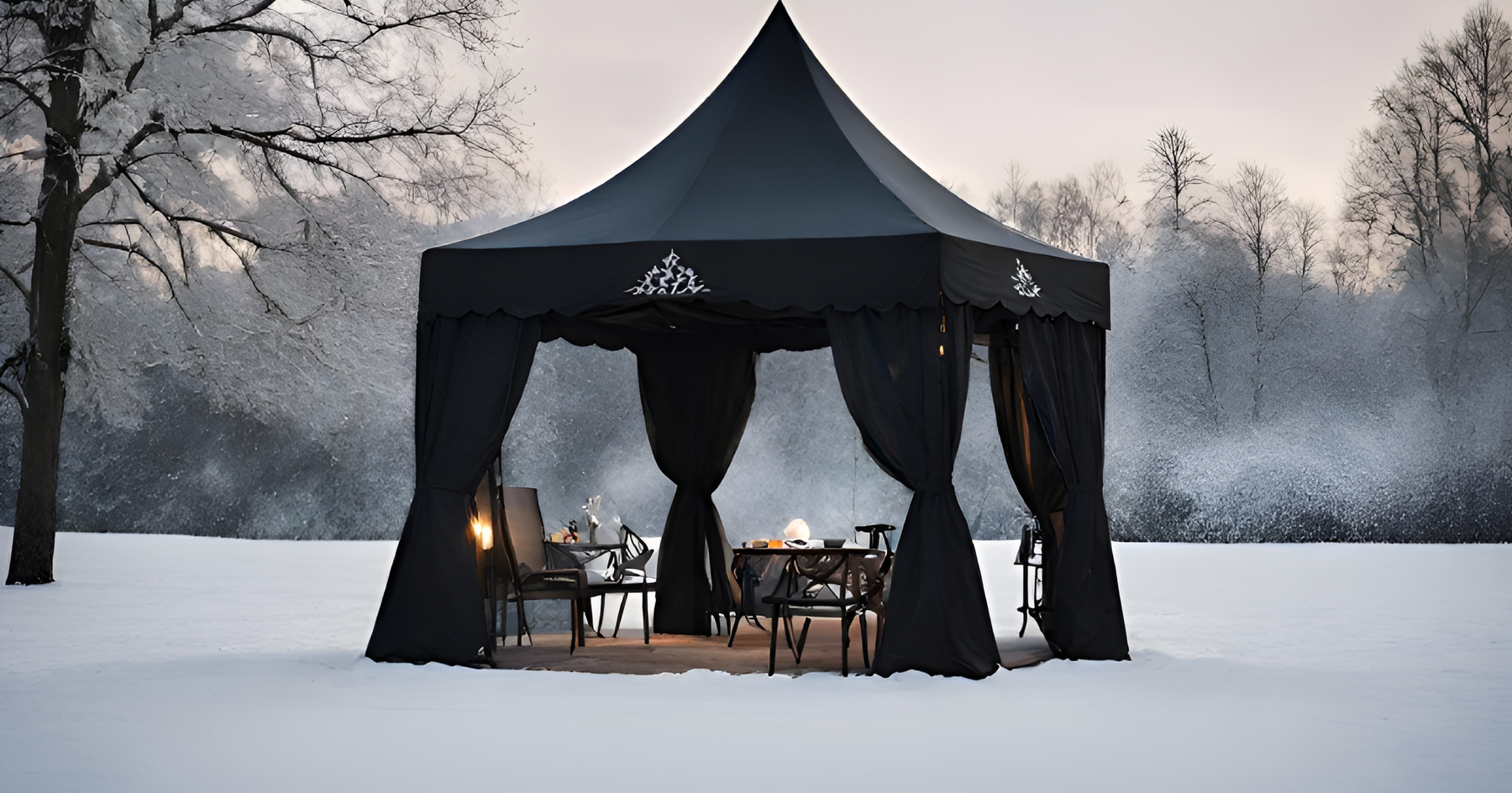
Winter-Proofing Gazebos: Can They Stay Outside?
As the winter season approaches, many gazebo owners may be wondering whether it is safe to leave their outdoor structures exposed to the cold weather. Gazebos provide a beautiful and functional space in our gardens, and it's only natural to want to preserve their beauty and longevity. In this article, we will explore whether gazebos can stay outside in winter and provide expert tips on winter care, protecting gazebos in cold weather, and winterizing outdoor gazebos.
Key Takeaways:
- Gazebos can withstand winter weather, but proper winterizing techniques are essential for their longevity.
- Protect your gazebo from freezing temperatures, heavy snowfall, and strong winds to prevent potential damage.
- Winter care for gazebos includes covering, sealing, and protecting materials from moisture and cold.
- Regular inspections for existing damage and applying weatherproof coatings are crucial for preserving gazebos during winter.
- Maintain your gazebo year-round with routine maintenance, inspections, and preventive measures.

Understanding the Challenges of Winter Weather
In this section, we will delve into the challenges that winter weather poses to gazebos. From freezing temperatures to heavy snowfall and strong winds, these elements can potentially damage your gazebo if not properly addressed. It is crucial to take proactive steps to prevent such damage and ensure the preservation and maintenance of your gazebo during the winter season.
Preserving gazebos during winter requires careful consideration of the following factors:
- Freezing temperatures: Extremely cold temperatures can cause materials to contract, resulting in structural issues or cracks. Additionally, frozen ground may cause uneven settling, leading to instability. By implementing appropriate precautions, you can maintain your gazebo's integrity during freezing temperatures.
- Heavy snowfall: Accumulated snow on the roof of your gazebo can exert significant weight, potentially causing structural damage. It is important to regularly remove snow buildup to prevent excessive strain. Additionally, taking preventive measures, such as reinforcing the roof or utilizing snow-friendly materials, can help mitigate the impact of heavy snowfall.
- Strong winds: Winter storms often bring harsh winds that can wreak havoc on vulnerable structures. Gazebos with intricate designs or lightweight materials are particularly susceptible to wind damage. By ensuring proper anchoring, reinforcing the framework, and selecting wind-resistant materials, you can enhance your gazebo's ability to withstand strong gusts.
By understanding and addressing these challenges, you can effectively maintain your gazebo in freezing temperatures and prevent damage during the winter season. In the following sections, we will provide you with practical tips and techniques to winterize and care for your gazebo, ensuring its longevity and enjoyment for years to come.
Winter Care Tips for Gazebos
When winter approaches, it's important to take the necessary steps to protect your outdoor gazebo from the harsh elements. By following these winter care tips, you can ensure that your gazebo remains safe, secure, and in optimal condition throughout the cold season.
Cover and Seal Your Gazebo
One of the first steps to winterize your gazebo is to cover it properly. Use a high-quality waterproof cover that fits snugly over the structure. This will prevent snow, ice, and moisture from accumulating on your gazebo, ultimately reducing the risk of damage.
Additionally, don't forget to seal any gaps or cracks in the gazebo's structure. Use weatherproof sealants or caulking to prevent cold air, moisture, and pests from entering the gazebo.
Protect the Materials
Each material of your gazebo requires specific care during the winter months:
- If your gazebo has wooden components, apply a protective sealant or waterproof stain before winter sets in. This will prevent the wood from absorbing moisture and protect it from rotting or warping.
- For metal gazebos, use a rust-resistant coating or paint to shield the metal from corrosion caused by winter weather.
- If your gazebo features fabric elements such as curtains or cushions, store them indoors during winter. Alternatively, opt for weather-resistant fabrics that can withstand exposure to cold temperatures and moisture.
Remove Snow and Debris
Regularly remove snow and debris from your gazebo to prevent excess weight and potential structural damage. Use a broom with soft bristles to gently sweep off snow from the roof, walls, and other surfaces. Avoid using sharp tools that could scratch or damage the gazebo.
Inspect and Maintain
Regular inspections are key to identifying any winter-related damage to your gazebo. Check for signs of rot, decay, or loose components. Replace any damaged parts promptly to prevent further deterioration.
Furthermore, during the winter months, continue with basic maintenance tasks such as tightening screws, lubricating hinges, and ensuring proper drainage. These small actions can significantly extend the lifespan of your gazebo.
By implementing these winter care tips, you can effectively protect your gazebo from the harsh winter weather and enjoy its beauty and functionality for years to come.

Preserving and Maintaining Your Gazebo During Winter
During the winter months, it is crucial to take appropriate measures to protect your outdoor gazebo from the harsh cold weather. By following these specific steps, you can ensure the longevity and durability of your gazebo throughout winter.
1. Inspect for Existing Damage
Before winter sets in, thoroughly inspect your gazebo for any existing damage. Look for loose fasteners, cracked wood, or any signs of structural weakness. Addressing these issues beforehand will prevent further damage during the winter months.
2. Apply Weatherproof Coatings
Applying weatherproof coatings to your gazebo is essential for protecting it from the elements. Choose a high-quality sealant or stain that is suitable for outdoor use and follow the manufacturer's instructions for application. The coating will create a protective barrier against moisture, snow, and freezing temperatures.
3. Safely Store Removable Components
If your gazebo has removable components, such as cushions, curtains, or decorative accessories, it is advisable to store them indoors during winter. These items are prone to damage from snow, ice, and moisture. Safely storing them will maintain their quality and extend their lifespan.
4. Clear Snow and Debris
Regularly clearing snow and debris from your gazebo will prevent the buildup of weight and potential damage. Use a broom or brush with soft bristles to gently remove snow from the roof, sides, and flooring. Be cautious and avoid using sharp tools or excessive force that could harm the gazebo's structure.
5. Ventilate the Gazebo
Proper ventilation is crucial even during the winter months. Allow for airflow within the gazebo to prevent moisture buildup, which can lead to mold and rot. This can be achieved by leaving windows slightly open or using adjustable vents to regulate air circulation.
6. Regularly Monitor and Maintain
Throughout winter, consistently monitor your gazebo for any signs of damage or deterioration. Address any issues promptly by repairing or replacing damaged components. Regular maintenance, such as cleaning and inspecting, will help preserve your gazebo's condition and prevent small problems from escalating.
By following these comprehensive guidelines for winter care, you can ensure that your gazebo remains in optimal condition throughout the cold months. Preserve the beauty and functionality of your gazebo while protecting it from the challenges of winter weather.
Ensuring Year-Round Durability
In this final section, we will explore additional measures you can take to protect your gazebo and ensure its durability all year round. By implementing these practices, you can prevent damage to gazebos in winter and maintain their longevity.
Regular Maintenance
Regular maintenance is key to protecting gazebos in cold weather. Perform routine inspections to identify any signs of wear and tear, such as loose or damaged components. Tighten screws and bolts, repair any cracks or breaks, and replace worn-out parts promptly to prevent further damage.
Inspect for Potential Issues
Before the winter season begins, thoroughly inspect your gazebo for potential issues that could worsen in cold weather. Check for leaks in the roof, gaps in the walls, or any areas where moisture might seep in. Seal these areas with weatherproof caulk or sealant to keep your gazebo dry and protected.
Implement Preventive Measures
Preventing damage to gazebos in winter requires proactive steps. Apply a protective coating to the wood, metal, or any other materials your gazebo is made of. This will provide an extra layer of protection against moisture, snow, and freezing temperatures.
- For wooden gazebos, apply a high-quality waterproofing sealant to prevent warping, rotting, and cracking.
- For metal gazebos, consider using rust-resistant paint or a clear coat to protect against corrosion and rust.
- For fabric gazebos, apply a water-repellent spray or treat the fabric with a waterproofing solution to prevent damage from rain or snow.
Additionally, consider investing in gazebo covers or tarps specifically designed for winter weather. These covers can add an extra layer of protection and help keep snow, ice, and other debris from accumulating on your gazebo.
By following these tips for winter maintenance for outdoor gazebos, you can ensure the durability of your gazebo throughout the year, protecting it from the harsh conditions of winter.

Conclusion
In conclusion, gazebos can withstand the harsh winter weather if proper winterizing techniques and maintenance practices are adopted. By following the tips and guidance provided in this article, you can confidently keep your gazebo outside during the cold months, preserving its beauty and functionality for years to come.
During winter, it is crucial to protect your gazebo from the freezing temperatures, heavy snowfall, and strong winds that can potentially cause damage. Take proactive steps such as covering and sealing your gazebo, protecting the materials from moisture and cold, and regularly inspecting for any existing damage.
Implementing preventive measures, such as applying weatherproof coatings and safely storing removable components, will further contribute to the durability of your gazebo. By investing time and effort into winter care for your gazebo, you can ensure that it remains a welcoming outdoor space all year round.
Remember, the key to maintaining a gazebo during winter is proactive maintenance and regular inspections. By taking the necessary precautions and following the recommended steps, you can enjoy the full benefits of your gazebo and extend its lifespan, even in the harshest winter conditions.
Other content you'll love:
Are Gazebos Waterproof? A Guide to Outdoor Shelters
Will Gazebos Hold Up in Snow? Find Out Here!
Relocating Your Gazebo? Can Gazebo Be Moved Tips
Mounting a Gazebo on Concrete: Is It Doable?
Installing a Gazebo on Grass: Is It Possible?
Gazebos and Lightning Safety: What You Need to Know
Gazebo Weights Reviewed: Are They Worth It?
Gazebo Tents: Good Choice for Outdoor Events?
Easy Gazebo Setup Guide: Are Gazebos Easy to Put Up?
Can Gazebos Go on Decking? Essential Tips & Ideas
Attaching a Gazebo to Your Home? Learn How!
Are Gazebos Safe in Wind? Stability Tips & Tricks
Are Gazebos Permanent Structures? Find Out Now!
Are Gazebo Covers Interchangeable? Find Out Here!


